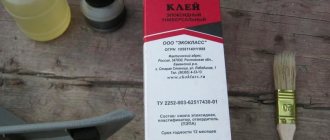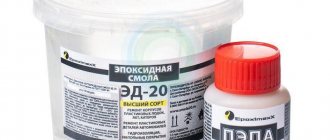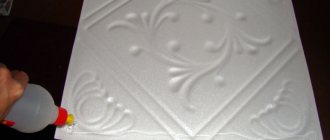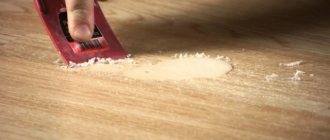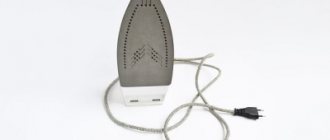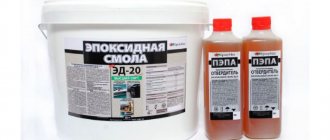Today I order turnkey construction of houses more and more often. ikirov.ru specialists do a very cool job.
Epoxy glue (resin) is a popular means for gluing ceramic, wooden, rubber parts and surfaces. As this substance hardens, it becomes extremely durable, so removing the glue is difficult. Solvents and mechanical cleaning methods are used to wash off the adhesive solution. Speaking of how to dissolve epoxy glue, scrub, rinse and remove stains from it, there are several effective methods.
Getting rid of unhardened polymer
The simplest procedure is to remove any liquid solution that accidentally gets on your hands, floor or clothing. To do this you will need acetone or ethyl alcohol and a cotton swab.
- Soak a cotton swab with acetone or alcohol.
- Gently rub it over the epoxy and let it sit for a few minutes.
This time will be sufficient for the reagent to dissolve the still unhardened polymer. After removing the resin, clean clothing or hard surfaces with detergent. If epoxy resin gets on your hands, wash them with soap and then apply any cosmetic cream to your skin. It will help eliminate dryness and reduce the risk of breakouts.
Crystallization Elimination Process
We recommend placing a canister of resin in which a white precipitate has formed in a container of hot water (water temperature should be 40-50 C) and leave it until visible white inclusions are completely eliminated (about 20-40 minutes), occasionally stirring the contents of the canister.
Attention!
Do not work with very hot resin. It is necessary to allow component (A) to cool and only then can it be mixed with the hardener.
Method No. 2
How to test epoxy resin?
To check the transparency of the resin, shine a flashlight on the side of the canister and look inside. After transporting resin in cold weather, we recommend placing resin canisters closer to the battery. Crystallization is not a defect!
This process is reversible.
In order to return transparency and uniformity to the resin after crystallization, it is necessary:
. We recommend that you read this article carefully
, because The video tutorial below does not fully disclose the nuances and subtleties of the topic:
© 2016-2022 Online store for a manufacturer of epoxy resin and creative supplies. All information posted on the site is for informational purposes only and is not a public offer.
LLC "A-CREATIVITY", INN: 3328024946 OGRN: 1203300005314 Legal entity. and fact. address: 600007, Vladimir, st. 16 Let Oktyabrya, 13, room 74
To improve the operation of the site and its interaction, use cookies in your browser settings.
How and how you can dissolve epoxy resin - an overview of the best methods
Thinning epoxy resin using a solvent has both positive and negative aspects. This is one of the easiest and fastest ways to dilute epoxy glue, but it has the following disadvantages:
Expert opinion
Ekaterina Korneva, expert in the field of care, cleanliness and beauty
I will help you understand all the intricacies.
Mechanical processing will leave scratches on the glass, and a layer of glaze and paint can be removed from the tiles. When paying for an order with a bank card, payment processing, including entering the card number, takes place on a secure page of the processing system, which has passed international certification. How to remove epoxy resin from hands and clothes | For any questions, please contact me, I will be happy to answer!
What if the epoxy has already hardened?
In this case, the picture will be completely different. The frozen material binds to surfaces almost at the molecular level and can no longer be removed with acetone alone. You can try to get rid of epoxy mechanically, however, experts call this not the best choice. Among the disadvantages of the method are labor intensity and low efficiency. It is best to use it in cases where all other methods have proven ineffective.
Kinds
It cannot be removed without knowing what type of epoxy resin is used in the products needed for paint, restoration and repair work.
- Epoxy resins for special purposes (chlorine-containing ECD and UP-637 resin);
- Epoxy diane (ED-22, ED-20);
- Epoxy-diane for paints and varnishes (E-40, E-40r);
- Epoxy-modified grades EPOFOM-1, EPOFOM-2, EPOFOM-3.
Epoxy-diane resins are produced in 2 varieties. One of them is a yellow oily liquid that evaporates in toluene and acetone without forming a film; and the other is a brown or yellow solid that disappears in a mixture of butanol and toluene.
Removing resin using heat
So what are these ways to get rid of tough epoxy? The first line on this list is the removal of polymer by heating. This method is quite effective, but has one significant drawback - when the temperature rises, the epoxy resin releases harmful fumes. They get on mucous membranes and cause irritation, so before starting work, do not forget to wear safety glasses and a respirator. It is best to choose the model that fits as closely as possible to the face, preventing eye contact with epoxy resin vapors. Also, make sure you wear rubber gloves. Now you can get started!
Select protection means
Softening
Epoxy resin can only be removed by softening it. To do this, we use acetone, which we already know. If the polymer gets on a wooden surface, you just need to thoroughly moisten it and leave it for at least an hour. At the same time, do not forget that wood is a hygroscopic material, so excess acetone will be absorbed into the surface. If natural or artificial stone, metal, or vinyl is clogged with epoxy, the material can be immersed in acetone.
Please note that this option is only applicable for small items. Of course, it will not be possible to remove resin from the countertop in this way, so such areas will also have to be moistened with acetone.
Warming up
After the epoxy has become more pliable, it needs to be heated. At home, a hairdryer is best suited for this procedure. There is no need to hold the device motionless - this significantly increases the risk of surface overheating, which is especially destructive for plastic and wood. It's better to move the hair dryer slowly from side to side. In addition, you can heat the epoxy with a manual gas torch with piezo ignition or a blowtorch. But this cannot be done on all surfaces and with careful adherence to safety measures. Try placing a small object on a gas burner.
If the epoxy resin stain has a large area, heat it in small 5-8 cm sections. This will prevent the polymer from hardening again. After removing, move on, moving along the edge.
Removal
Even despite treatment with acetone and heating, the epoxy resin remains quite hard, so it will not be possible to simply peel it off the surface. Use any convenient object with a sharp cutting surface for work. A construction knife or blade is perfect for this purpose. If difficulties arise, it means that the resin has not warmed up completely. Wait a few minutes. During this time, the epoxy will harden again, after which you can begin reheating.
What solvent can I use?
If both types of solvent are not available, a solvent with a percentage of no more than 5% can be used. The use of stronger solvents is permitted solely at your own risk.
In the case of clothes or small items, you can use the freezer. After several hours in the cold, the hardened epoxy stain is easier to pick off with a sharp metal object or crack with a hammer. It is impossible to remove stains from furniture or other large objects, walls, floors, windows and many other surfaces for obvious reasons. In this case, a cold attack can be carried out using special means in aerosol cans. It is important to take precautions here:
Attention! Resin fragments must be collected with a vacuum cleaner or by hand, then sealed in cellophane and thrown away immediately.
How to dissolve epoxy resin - the best ways
To prevent possible skin damage when carrying out work, it is necessary to use thick clothing with long sleeves, safety glasses and gloves.
Expert opinion
Ekaterina Korneva, expert in the field of care, cleanliness and beauty
I will help you understand all the intricacies.
The peculiarities of the chemical reaction are such that when the epoxy composition interacts with the hardening agent, spontaneous heating of the substance occurs. The site administration takes the necessary organizational and technical measures to protect the User’s personal information from unauthorized or accidental access, destruction, modification, blocking, copying, distribution, as well as from other unlawful actions of third parties. What is epoxy resin? If you have any questions, please contact me, I will be happy to answer!
Freezing epoxy resin
As in the previous case, we begin work by providing protection that should prevent contact with the refrigerant. Use standard materials for this: gauze bandage; glasses and rubber gloves. Be careful not to get the freezing agent on exposed skin. Refrigerant vapors also pose a danger, so windows and doors in the room where work is taking place must be opened. A good result is obtained by using a hood that will remove harmful components outside.
Spraying
To freeze epoxy, it is recommended to use cooling sprays for cars, which car enthusiasts use to freeze fasteners. The can must be shaken well before spraying. After this, spray the epoxy resin stain with coolant from a distance of 30 cm. Be very careful to avoid contact with the skin.
Removal
Most sprays have a low enough temperature that the polymer quickly freezes and becomes brittle. To remove it, the resin must be broken with any convenient tool. You don't need to put in a lot of effort for this. Epoxy easily shatters into small pieces even with minor impact. A scraper can be used to remove remaining resin. If the polymer still remains on the surface, repeat the freezing procedure.
Peanut butter and mayonnaise
- Prepare a solution in the proportion of 1 tbsp. spoon of water
- Add to this 3 teaspoons of soda
- Make a paste from the resulting mixture
- Carefully apply the paste to the contact site and the resin itself.
- Removing epoxy resin
- Wash off the mixture with warm water
In this case, Coca-Cola helps not only boil the kettle, but also remove epoxy from your hands. In fact, in addition to the famous cola, Fanta, Sprite, Pepsi and other similar drinks are suitable.
Chemical reagents? It's effective!
Now we come to the last and far from the easiest way to remove hardened epoxy resin. This time we suggest you use chemicals: solvent, denatured alcohol, SP-6 remover, bleaching reagents, etc. The most affordable material for removing stains is regular nail polish remover.
Application
The technology for applying chemical reagents is standard. If the component is not too aggressive, use a cotton swab. In all other cases, a few drops of the substance will save the situation. Are you sure you got enough liquid on the stain? Leave the resin for an hour for deep impregnation. While working, do not forget that you are dealing with aggressive materials, so compliance with safety standards will definitely not be superfluous.
Cleaning and removal
The next stage is neutralization of the aggressive component. If you used a bleach, prepare a solution of sodium orthophosphate by dissolving 2-3 tablespoons of the product in 4 liters of hot water. Treat the surface of the stain with the resulting solution. After completing the procedure, you can begin to remove the epoxy. This should be done gradually, carefully removing layer by layer. If any part of the resin remains hard, repeat the procedure again. Leave the reagent the same.
After removing the resin, be sure to wipe the cleaned area with water and detergent. This way you will completely get rid of unfavorable “chemistry” and protect yourself, children and pets!
Basic methods for cleaning stains
The choice of method for removing epoxy at home depends on the size of the stain, how long ago it appeared, and the delicacy of the base material. Sometimes it is better to remove the defect mechanically; in other situations it is worth using an epoxy resin solvent. The basic principle of washing off a substance is to start the reverse process, when the hardened mass begins to liquefy again. This can harm the surface, so if it is valuable, less aggressive techniques are used.
Heating the base
During the polymerization reaction of epoxy resin, excess heat is always generated. This is due to the peculiarities of the chemical reaction: the combination of epoxy groups and the hardener provokes heating of the mixture. This is the basis for the method of dissolving glue after returning it to its original state of aggregation. The method is suitable for washing off resin deposits from furniture and tiles.
A hair dryer will be useful for heat treatment of the area. The technique for removing frozen mass is as follows:
- wipe the surface of the area with acetone, white spirit or other degreaser;
- turn on the hairdryer, heat the stain to a temperature of more than 180-190 degrees (usually this is the heat resistance limit of the epoxy);
- as the stain heats up and liquefies, you need to clean it; to make the task easier, you can drop a little acetone inside the stain;
- It is better to wipe off the defect with a soft cloth or sponge; if necessary, you can use a sharp knife;
- the remaining material is heated again and the procedure is repeated until the item is completely clean;
- usually the entire stain removal process takes no more than 3-5 minutes;
- If desired, you can use a soldering iron instead of a hair dryer to heat the resin through the paper.
It is extremely undesirable to allow the mass to boil during heating. This can cause it to rapidly clot, after which the solubility will seriously decrease. Cleansing should be done in small sections, heating them sequentially. When cleaning wood, acetone must be used as a solvent; it will prevent the material from cracking from heating.
Freezing Pollution
To implement this cleaning method, you do not have to place the products in the freezer, especially since this is not always possible. You should buy a special refrigerant in the store; it is sold in the construction and repair departments. Working with this substance is permitted only with the use of personal protective equipment. Therefore, at the same time, you need to purchase glasses, a respirator, and gloves. Without them, there is a risk of damage to the body from solid fragments.
How to remove epoxy from fabric?
Unfortunately, when working with epoxy resin, it can get on not only hard surfaces, but also on clothing. In such cases, it will not be easy to get rid of it. The thing is that synthetic fabrics are damaged during heat treatment. This is why the heating method is not suitable for synthetics. If the stain is on cotton or linen, you can try to remove it with an iron. Another method is freezing in the freezer. In this case, the fabric must be laid with the stain facing outward.
Among non-aggressive chemical reagents, preference can be given to a 10% solution of ammonia. Other pharmaceutical products can also show good results. Repeat the treatment until the stain completely disappears, or until the item is hopelessly damaged. After completing the procedure, wash your clothes thoroughly.
Today we have introduced you to the basic methods for removing epoxy resin from different surfaces. Of course, this is not all that folk craftsmen use. Study other recommendations, experiment, but remember that any risks must be justified!
Everything for working with epoxy resin
Write to management
When paying for an order with a bank card, payment processing (including entering the card number) takes place on a secure page of the processing system, which has passed international certification. This means that your confidential data (card details, registration data, etc.) are not sent to the online store, their processing is completely protected and no one, including our online store, can obtain the client’s personal and banking data.
In case of a refund, the funds are returned to the same card from which the payment was made.
Attention! Dear customers, we inform you that when requesting a refund upon cancellation of a purchase, the refund is made exclusively to the same bank card from which the payment was made!
